- Home
- Encyclopedia
- Mormon Colonizers In Wyoming’s Bighorn Basin
Mormon Colonizers in Wyoming’s Bighorn Basin
From 1847 to 1900, members of the Church of Jesus Christ of Latter-day Saints (the Mormons) founded hundreds of settlements throughout Utah and the Intermountain West. One of the last places they settled was in the Bighorn Basin of northern Wyoming, where they established the towns of Byron and Cowley in the fall of 1900. They also moved into the existing settlement of Lovell, where they quickly outnumbered the original non-Mormon settlers and redefined Lovell as a Mormon town.
The northern basin was already home to a small group of Mormons who had settled in Burlington, Wyo., beginning in 1893. Their success brought the area to the attention of LDS Church leaders, and this, along with encouragement from Wyoming government leaders, led to an official church-sponsored colonization project known as the Big Horn Basin Colonization Company. It was organized on April 9, 1900, for the purpose of building an irrigation canal north of the Shoshone River and establishing agriculture and communities in the Bighorn Basin. The company was led by LDS Church Apostle Abraham Owen Woodruff along with Byron Sessions, Jesse W. Crosby and Charles A. Welch, all of whom were prominent men in Utah. Sessions, Crosby and Welch would go on to become the top ecclesiastical leaders of all Mormons in the Bighorn Basin.
Since the late 1800s people in many Mormon communities in Utah and Idaho had been looking for new places to settle. This was particularly true among those from southern Utah, where farming was hard and water scarce. Land was also becoming scarce as settlements in Utah, Idaho and Wyoming filled up. Articles appearing in the Church-run newspaper, The Deseret Evening News, promoting the new colonization project in “the Big Horn,” as the editors called it, found a receptive audience. Leaders of the company also personally recruited settlers from among their friends, family and neighbors.
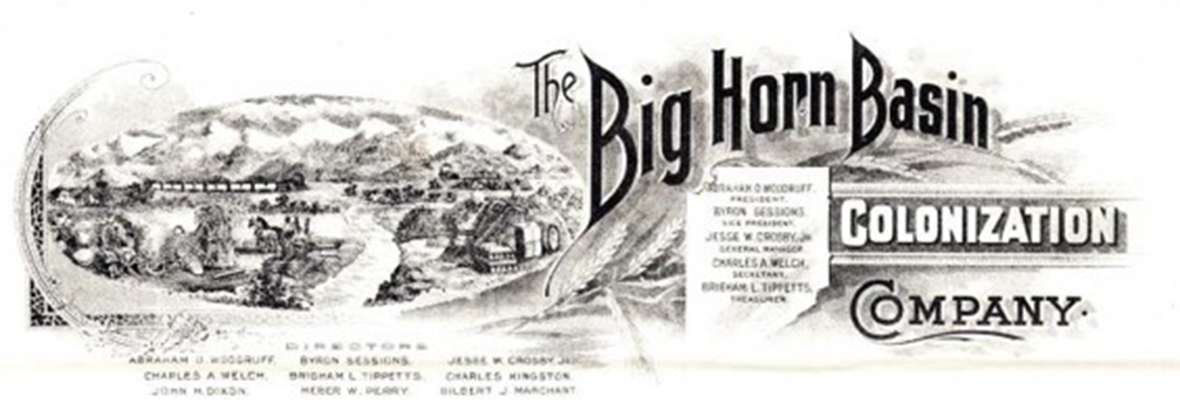
Twin brothers Aaron and Eleazer Asay, dissatisfied with their economic prospects in Utah, went to Arizona, Nevada and New Mexico in early 1900 looking for opportunities before finally returning home to Parowan, Utah, without success. There they found Jesse W. Crosby recruiting people to move to Wyoming and decided to join him. They were among the first of what would be a large migration of the extended Asay family into the Bighorn Basin.
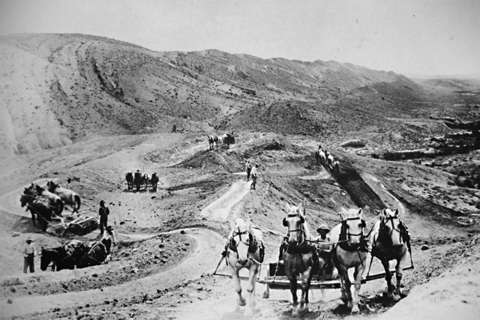
The Asay family’s move came as a result of the most successful means of promotion: word of mouth. People heard from their neighbors and relatives that there was cheap land with a sure water source—the Shoshone River. This accelerated after the first settlers started sending back accounts of the area to their families. Leland Harris wrote, “My father … was looking for a place where plenty of water and larger tracts of land were available … Uncle Haskell Jolley and Uncle George Averett were in the Big Horn, and frequent letters … gave glowing accounts of the unlimited supply of water and land to be taken by homesteading.” Nearly everyone who came had extended family members who also came. This migration of large families mostly took place between 1900 and1905.
Working for community and cash
For those first settlers who arrived in May 1900, the canal was of utmost importance. Water rights in the river—still at this time called the Stinking Water, until the Wyoming Legislature changed its name to Shoshone in 1901—had been relinquished to the company by William F. “Buffalo Bill” Cody so construction of the canal could proceed. Called the Sidon Canal, it would be completed in 1904, a 37-mile-long course winding between the towns of Byron and Cowley. A hundred years later, it continues to flow, diverting water from the Shoshone River to farms in northern Big Horn County.
Building of homes was put off, and the settlers camped out all summer and into the fall. Charles Welch wrote, “No houses had been built … some had tents, others sheep wagons …” Eliza Black remembered, “Tents were lined up and down along the river.” Camping in the sagebrush, dealing with the nearly constant wind blowing across the canal construction site meant dirt and sand were everywhere. In a letter to her mother, Black wrote, “My clock won’t run anymore it is so full of sand.” She later remembered there being “sand in everything.”
About that sand, Welch said, “Day after day, week after week, and month after month it was ditch, ditch, ditch [digging the canal], and it took grit to keep it up. The grit was furnished by the winds that came up day after day as the table (usually a box) was laden with food to eat, and the puff of wind would cover the table with sand. You could write your name in the sand on the plate.”
In the fall, I.S.P. Weeks, from the Chicago, Burlington and Quincy Railroad, met with Woodruff and offered the Mormons a contract to build a railroad line from Montana to Cody. The colonists considered this divine intervention, as they were in desperate need of cash for supplies. Jesse W. Crosby was chosen by the Company to direct work on the railroad with one group of settlers. The rest, led by Byron Sessions, continued to work on the canal. The men earning wages from the railroad split them with the canal men, and the canal men split their pay of canal stock with the railroad men. This was the first of many building contracts the Mormons would undertake over the next several years. Mormons built several other canals in the Basin and southern Montana, roads, other railroad lines, and the Dome Lake Reservoir in the Bighorn Mountains.
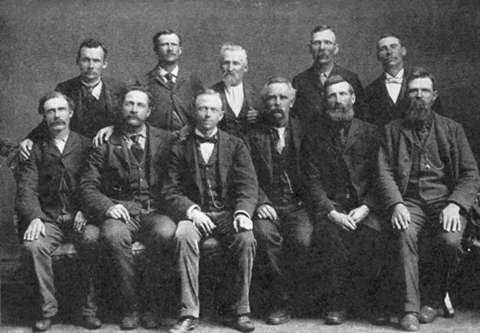
In September 1900 the town sites of Byron and Cowley, approximately seven miles apart, were laid out, and settlers drew for their lots, many becoming owners of tracts they had not even seen. After the drawing, Welch said, “men could be seen going in all directions to find out where their homes were to be found.” Work on the canal was postponed while people began building homes for the winter. In addition to the new communities of Byron and Cowley, Mormon colonists began to buy land and build in and around the existing settlement of Lovell, seven miles northeast of Byron and six miles southeast of Cowley.
Lovell becomes a Mormon town
Unlike Byron and Cowley, which were started from scratch, Lovell had settlers who had already been living there for several years. Josiah Cook, known as the first white settler in the area, arrived in 1877. He called his place, located just north of the Shoshone River, Cook’s Road Ranch, and it served as a stopping place for the cowboys and ranch hands who inhabited the basin in the final decades of the 19th century. In 1888—12 years before the Mormons came—Cook established a post office named for Henry Lovell, the well-liked owner of a nearby cattle ranch.
In 1894, Frank and Ellen Strong came across the Big Horn Mountains from Dayton, Wyo., and acquired 720 acres of land, just south of the Shoshone River, and about ten miles west of the Bighorn River in and around what would become the Lovell town site. They built a hotel, livery and saloon. The Strongs sold land to many of the Mormon settlers when they began to arrive six years later. By then Lovell consisted of some ranches, ferries, a hotel, a saloon and a store or two. Irrigated agriculture had also begun: The Hunt and Godfrey Canal and the Globe Canal were already in use in the Lovell area when the Mormons arrived.
With this large influx of Mormon settlers beginning in May 1900 and continuing through the next several years, Lovell was thoroughly transformed into a Mormon town. When the 1900 U.S. Census was taken in June, Mormons were already a clear majority of the population: In the Lovell precinct, 452 people were listed with only 31 percent non-Mormon. By 1910, the majority was even greater: 83 percent Mormon to 17 percent non-Mormon. Upon Lovell’s official incorporation on Oct. 26, 1906, the first mayor, George Johnson, and councilors M. David Harris, Frank H. Ostler, Elias Johnson and Alma Peterson were all Mormons.
Some of the Mormons had some mild concerns about the non-Mormons they were living among. Eliza Black remembered being surprised when she first met Lovell residents Ellen Strong and her daughter. “It was the first time I had seen women ride astride,” she wrote. Mormon Clara Brown, regretting the lack of schools in her new town, wrote, “The people who have lived here do not care much about education or religion or politics.” A December 1903 letter from Robert Moncur describing the colony to people back in Utah mentions that, “as to society,” Lovell has a “variety” [not everyone was Mormon], including a “saloon element.” Despite these reservations, Moncur noted that everyone shared the same church building, and Mormon settler Maggie Barnes remembered the Strong and Cook families being “very friendly” and “fine people.”
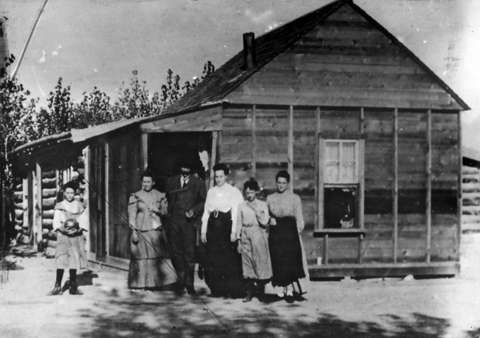
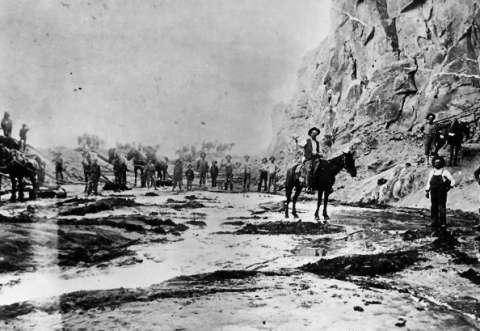
Among the original settlers of Lovell, most did not appear to be troubled by their new neighbors. They willingly sold the Mormons land and worked with them to build up their new community. Original settler Roxie Cook recalled, “[In 1899] we learned that a colony of Latter-day Saints was coming to Lovell the next spring … I was in the receiving line to welcome them, and I will say . . . I have many fine friends among them.” Non-Mormon Will W. Murphy had a warm relationship with Mormon Bishop Haskell Jolley, whom he called “a ‘man among men.’”
Outfoxing the Burlington
According to Murphy’s account, “Early Life in the Big Horn,” one matter Mormons and non-Mormons worked together on was “trying to figure out a way so the town could expand without filling the pockets of a rich corporation at the expense of good honest people.” The officials of Lincoln Land Company, closely connected with the Burlington Railroad, had purchased all the vacant lots in Lovell’s business district. They then immediately laid out a new town site where the depot would be, hoping to sell the new business lots at a high price, and refusing to sell the old lots. Murphy, Jolley and some others formed the Lovell Investment Company, which bought several lots south of the depot. One night they physically moved many of the already existing businesses to those lots, creating a new business district. Murphy remembered, “The people of Lovell awoke to find the post office, the Chronicle office, my real estate office and a few other buildings moved over on the Lovell Investment Co.'s lots.”
End of an era
The Bighorn Basin was one of the last areas of the western frontier to be settled, and, as the frontier was closing, the era of Mormon colonization was necessarily coming to an end. Mormon colonists, along with the original settlers of Lovell, built three viable towns during this time of transition.
Perhaps one reason the non-Mormons welcomed the Mormon settlers was that they brought, as one historian argues, a new kind of social and political stability to what had for some time been a rough and lawless part of Wyoming. At least three and probably four Mormon farmers sat on the 12-man jury that convicted cowboy Herb Brink of murder after the notorious Spring Creek Raid in 1909; the jury foreman, W.H. Packard of Burlington, was a Mormon bishop. Brink and four others were charged with murdering three sheepmen in a raid that climaxed a decade and a half of violent, unpunished crime against sheep and sheepmen in that part of the state. The Mormons, argues historian John Davis, came from a culture that had "suffered terribly from vigilantism" whose people "were not about to wink at the violent actions of cowboys." The conviction brought in a new era that no longer tolerated lawlessness, he says.
The Mormon colonization of the Bighorn Basin in the early years of the 20th century coincided with the end of an era in the history of both the LDS Church—and the West.
Resources
Primary Sources
- Barnes, Maggie. “Historical Events,” unpublished paper, no date. Familysearch.com. Accessed July 24, 2015, at https://familysearch.org/patron/v2/TH-303-47566-544-12/dist.pdf?ctx=ArtCtxPublic&session=USYS767C8D91529D189DA433234DCF152E78_idses-prod03.a.fsglobal.net.
- “Big Horn Basin Colonization,” Deseret News Evening News, Feb. 5, 1900. Utah Digital Newspapers, accessed July 24, 2015 at http://udn.lib.utah.edu/cdm/ref/collection/den1/id/14827.
- Black, Rosa Vida Bishchoff, compiler. “Mother Stood Tall: Writings and History of our Mother, Eliza Rosetta King Black Lythgoe, Wife, Pioneer, Educator, Writer, Friend, Mother of Utah and Cowley, Big Horn County, Wyoming, 1875-1955.” Self-published, no date.
- Brown, Clara to Harriet M. Young Brown, Feb.10, 1902, Harriet M. Young Brown Papers. LDS Church History Library, Salt Lake City, Utah.
- “Camping in the Big Horn Basin,” Deseret News Evening News, July 31, 1900. Utah Digital Newspapers, accessed July 24, 2015 at http://udn.lib.utah.edu/cdm/ref/collection/den1/id/68072.
- Crosby, George H., Jr. “Colonizing the Big Horn Basin,” Deseret Evening News, March 20, 1903. Utah Digital Newspapers, accessed July 24, 2015 at http://udn.lib.utah.edu/cdm/ref/collection/den7/id/59088.
- “Headed for the Big Horn Basin,” Deseret Evening News, April 21, 1900. Utah Digital Newspapers, accessed July 24, 2015 at http://udn.lib.utah.edu/cdm/ref/collection/den1/id/74194.
- Harris, Leland, portion of undated typescript journal/life history given to the author in 1996 by his daughter, Delsa Harris Asay (1925-2008).
- Lythgoe, Eliza R. “Colonization of the Big Horn Basin by the Mormons.” Annals of Wyoming 14, 1942 1:39-50. Lythgoe is early colonizer Eliza Black, who married Thomas Lythgoe after the death of her first husband, John Black.
- Moncur, Robert. Letter to the Spanish Fork Press, Dec. 9, 1903 in “Historical Records and Minutes of Lovell Ward,” Manuscript Histories of the Units of the Church, LDS Church History Library, Salt Lake City, Utah.
- Murphy, Will W. “Early Life in the Big Horn,” Lovell Chronicle, May 23, 1946. In Black, Rosa Vida Bischoff. Lovell: Our Pioneer Heritage. Salt Lake City: Olympus Publishing Company, 1984, 187-188.
- “Our Neighbors,” Deseret News Evening News, Feb. 21, 1900. Utah Digital newspapers. accessed July 24, 2015 at http://udn.lib.utah.edu/cdm/ref/collection/den1/id/17976.
- Partridge, Mark N. With Book and Plow: History of a Mormon Settlement. Lovell, Wyo.: Mountain States Printing Company, 1967.
- Record of Members Collection, Big Horn Stake, 1901-1941, LDS Church History Library, Salt Lake City, Utah.
- Strong, Ellen. Untitled account, June 3, 1949. In Black, Rosa Vida Bischoff. Lovell: Our Pioneer Heritage. Salt Lake City: Olympus Publishing Company, 1984, 25-26.
- Town of Lovell, Town Council Minutes, October 26, 1906, Lovell, Wyo.
- U.S. Bureau of the Census, 1900 Census. Lovell, Wyo.
- U.S. Bureau of the Census, 1910 Census. Lovell, Wyo.
- Welch, Charles A. “Exploring the Big Horn Basin,” Deseret Evening News, Feb. 19, 1900.
- Utah Digital Newspapers, accessed Aug. 3, 2015 at http://udn.lib.utah.edu/cdm/ref/collection/den1/id/17654.
- ______________. History of the Big Horn Basin. Salt Lake City: Deseret News Press, 1940.
Secondary Sources
- Asay, Flossie W. Descendants of Joseph and Sarah Ann Asay. Provo, Utah: J. Grant Stevenson Printing, n.d.
- Black, Rosa Vida Bischoff. Lovell: Our Pioneer Heritage. Salt Lake City: Olympus Publishing Company, 1984.
- Bowen, Marshall. “Migration to and from a Northern Wyoming Mormon Community.” Pioneer America, 9, no. 2 (Dec. 1, 1977): 208-227.
- Davis, John W. Goodbye, Judge Lynch: The End of the Lawless Era in Wyoming’s Big Horn Basin. Norman, Okla.: University of Oklahoma Press, 2005, 164-170.
- ____________. Email message to WyoHistory.org, July 28, 2015.
- Gallagher, John S. and Alan H. Patera. Wyoming Post Offices, 1850-1980. Burtonsville, Md.: The Depot, 1980.
- Graham, D. Kurt. The Mormon Migration to Wyoming’s Big Horn Basin in 1900, Master’s Thesis, Provo, Utah: Brigham Young University, 1994.
- Harris, Winifred Porter. “Shoshone Valley Before 1900.” In Gems to Treasure, Big Horn Stake of the Church of Jesus Christ of Latter-day Saints. Cody, Wyo.: Cody Enterprise, 1960, 125-129.
- Sherlock, Richard. “Mormon Migration and Settlement After 1875,” Journal of Mormon History 2 (1975), 52-68.
- Wood, Lawrence M. Wyoming’s Big Horn Basin to 1901: A Late Frontier. Spokane,
- Wash.: The Arthur H. Clark Company, 1997.
Illustrations
- The letterhead of the Bighorn Basin Colonization Company is from the collection of Ardis Parshall, and was posted by her on her Mormon-history blog site, Keepapitchinin. Used with thanks.
- The photos of the leaders of the Big Horn Basin Colonization Company and of the horse scrapers working on the Sidon Canal are from the collections of the Cody Murals Historic Site. Used with permission, and special thanks to David O. Smiley.
- The photos of the Sessions family and of a horseback Byron Sessions during canal construction are from the photo collections of the Simmons family. Both are now in the possession of Reta Simmons of Lehi, Utah, and were originally collected by Bertha Sessions Simmons. Used with permission and thanks.
